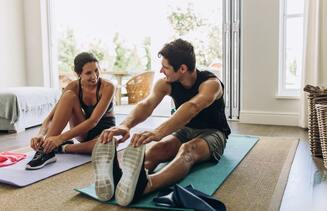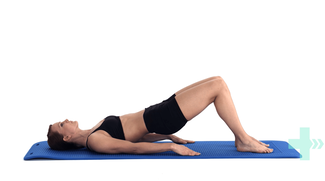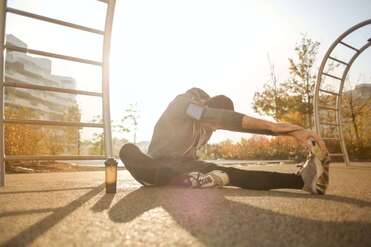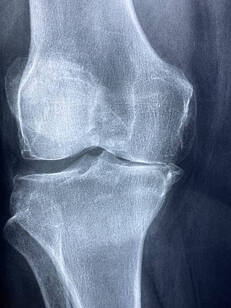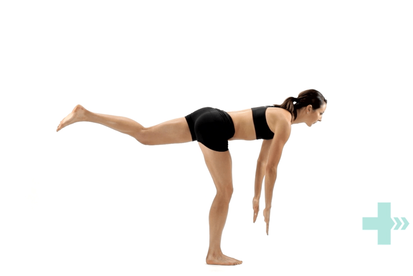|
Stretching has long played an important role in the world of sport and fitness, with many athletes stretching religiously before and after exercise in hopes of preventing injuries. More recently, this practice has been called into question with many people wondering if stretching really makes a difference to athletic performance. The answer, like most things, is not black and white, as we explore a little in this article. A brief introduction to stretching
Stretching is a type of movement that increases flexibility by lengthening muscle fibres to the end of their range. Stretching before and after exercise has been thought to reduce the risk of injury, improve athletic performance and reduce muscle soreness after exercise. The two most common types of stretching are static and dynamic stretching. Static stretching is when you lengthen your muscle and then hold that position for a period of time. Dynamic stretching uses movement and momentum of the body to stretch muscles to their end range, without holding the stretch at the end. What does the research say? Some research has suggested that static stretching before an activity can actually reduce power, strength and performance. However, these reductions were shown to be minimal and not noticed at all if the stretches were held for less than 45 seconds. It has also been found that stretching does improve flexibility but only for a short period of time. A few minutes after stretching, your joints move further, and with less resistance, so you may have improved flexibility immediately after stretching. Why stretch at all? One thing that is undeniable is that stretching feels great, with many people feeling more relaxed and reporting a rush of endorphins after a good stretching session. It is also difficult to test the long-term effects of stretching specific muscles showing abnormal tightness. A long-term static stretching routine will improve your overall flexibility, and this is thought to help prevent injuries, although the evidence is inconclusive. If you’re an athlete, the decision to stretch or not can be a personal one. A warm-up prior to intense exercise that includes some form of dynamic stretching is generally recommended for reducing injury risk, but of course is no guarantee. Strength and balance training may have a far greater impact on reducing injuries in the long term. Your physiotherapist is able to guide you on the best stretching advice for your individual activity and they may be able to identify some areas where improving your flexibility will help to reduce injuries and improve performance.
0 Comments
While there are many benefits to be gained from effective stretching, employing an improper technique can actually result in injury. Here are some tips and guidelines for you to follow when stretching... - Warm up first with an activity such as walking (at least 5 -10 minutes).
- Stretches should be pain-free. You should only feel tension or a tight feeling when stretching. If you feel a sharp pain, this means you're stretching too far. - Don't hold your breath while stretching, keep breathing to ensure the muscle tissues remain oxygenated during the stretch. - Stretch both sides. But if one muscle is tighter than the other, focus on it more until they're both in the same range. - Avoid bouncing at the end of the stretch because it may lead to injury. - Hold stretches for 20-30 seconds, if not longer. A 10 second stretch is not always enough to achieve a lasting effect. - Repeat the stretch 3-5 times with intermittent rest periods in between. - Make sure your body is aligned properly and observe good posture. When to Stretch? Traditionally, stretching has been encouraged before and after any kind of physical activity. However, recent studies show that there is no discerning difference between whether you stretch before exercise/sports or not, both in terms of performance and injury prevention. In some cases, researchers say that it's okay to omit the pre-event stretch since the post-event stretch is much more beneficial. Some of our everyday postures and activities can lead to certain muscles becoming tight while the others sit in a lengthened position. These habitual postures that lead to muscle imbalances then become more and more difficult to correct over time. Many therapists will suggest that stretching all muscles generically isn’t as beneficial as identifying which of your muscles are abnormally tight and developing a targeted stretching regime. Talk to your physiotherapist for advice regarding the best stretching program for your body type, posture and activity levels. An essential component of physiotherapy treatment is your home exercise program. All physiotherapists know that patients who complete their exercises will have better outcomes from their treatment, however it can be difficult to find time to complete them. Here are a few tips that can help you to fit your exercises into your weekly routine. Plan when to complete them
Making a plan might sound simple, but the expression 'failing to plan is planning to fail' has some truth to it. Physiotherapy exercises are specifically targeted towards weak and tight muscles. The exercises are likely to be a little difficult and uncomfortable. Setting a particular time aside in advance to complete them can help you overcome any resistance to getting them done. Ask your physio to prioritise them Your physiotherapist might give you a combination of exercises to complete. If you're struggling to find time to complete them all, ask your physiotherapist to rank the exercises in order of importance, this can help you to make sure you complete the most important ones when you are short of time. Set triggers as reminders You can use small every day tasks as reminders to remind you to complete your exercises. Some examples include boiling the kettle, brushing your teeth or as a final task before getting into bed. Use positive reinforcement Combining a task you don't enjoy with one that you do is a great way to motivate yourself. You can either pair your exercises with something you love such as watching an episode of your favourite tv show or give yourself a reward once they are completed. Either way, the more positive associations you make with completing your home exercise program, the less barriers you make to completing them! Want more tips? Ask your physiotherapist for their top tips and tricks for fitting your exercise program into your day. Our muscles obviously play an important role in the movement of our body. Without them, we wouldn’t be able to bend our elbow or straighten our leg. As our muscles are soft and designed for flexibility, they are also prone to injury and if you have ever torn a muscle, you know that they can be very painful. In the period following a muscle tear, there are a few mistakes we often see people make that can make their injury worse and delay healing times. Here are a few of the most common mistakes we see... 1. Stretching
After a muscle tear, the damaged fibres slowly begin to heal and reattach to each other. This process can be quite fragile and during the early stages, aggressive stretching of recovering tissue can impair healing or even lead to more tearing. While gentle stretching a few days after the injury can have a positive effect, you should check with your physiotherapist to ensure you’re not stretching too far and causing further damage. 2. Applying H.A.R.M. Most of us are aware of the acronym R.I.C.E (rest, apply ice, compress the area and elevate) as the recommended treatment in the early stages of an acute injury. The acronym H.A.R.M is less well known and is used to remember the things you shouldn’t do after an injury. This stands for applying heat, drinking alcohol, running or massage. All of these activities can increase swelling, pain and increase the damage of the injury in the first 48-72 hours. 3. Failing to see a physiotherapist The diagnosis of a muscle tear might seem straightforward, however, there might be more going on than you realise. Many conditions can mimic a muscle tear, or you may have suffered a tear due to an underlying weakness or pathology. Having a physiotherapist confirm your muscle tear and identify any other issues is vital to ensuring you recover fully. Your physiotherapist is also able to identify any factors that could lead to further injury and is able to help restore your tissue to its previous level of strength and function. 4. Returning to sport too early One of the most confusing things about muscle tears is that they often become less painful while the tissues are still not completely healed. Many people suffer another tear simply because they return to sport too early. While you may feel as though your tissues are back to full strength, the muscle fibres can still be healing and vulnerable to further injury. It is important to test your injury gradually, starting with gentle exercise and building up to more high intensity activities. Your physiotherapist is able to guide you with a full rehabilitation program. This can help to restore strength, flexibility and control to your damaged muscle, keeping you injury free for the future. We know that office life can wreak havoc on our body. Even with the best intentions, finding time to reverse the pressures of 8 hours a day sitting in a chair can be difficult. Here are three easy stretches to do daily that focus on common problem areas for office workers. Chest & shoulders stretch (wall angels):
Find a large flat wall and stand facing away from it. You may need to bend your knees slightly or step a few inches forward. Your pelvis, upper back and back of your head should all be in contact with the wall, with small gaps where the curves of your spine are. If you are unable to keep your head to the wall, you may need to use a towel behind your head to make this position comfortable. Tuck your chin in gently, keep your palms facing forward, elbows bent to ninety degrees with the backs of your arms against the wall. Now slide your arms up along the wall, as high as you can while keeping them in contact with the wall, pause for a few seconds and slide them down again. Repeat 5 to 10 times. This will stretch your chest and shoulder muscles which get tight from slouching at a desk, as well as help you to develop a sense of head position alignment with your body. Hip flexor stretch (lunge): Kneel on one knee, place your other foot on the floor in front of you and keep your knee bent to 90 degrees. Keeping your hips even, shift your pelvis forward but keep your shoulders back until you feel a stretch at the front of your hip of the kneeling leg. Hold for 30 to 45 seconds and then swap legs. Repeat 2 to 3 times. This will stretch your hip flexor muscles which are often tight from sitting for long periods. Seated hamstring stretch: Sit on the floor with one leg straight out in front of you. Bend your other leg and tuck your foot in towards your inner thigh. Reach forward with both hands and stretch towards your foot on the straightened leg, bending at your hips as much as possible. You should feel a stretch at the back of your thigh, if you feel a pull behind your knee you can point your toes or bend your knee slightly. Hold for 30 seconds and slowly come back up, change legs and repeat 2 to 3 times on each leg. Check with your physiotherapist if there are other stretches that may benefit you. Why are workplace injuries so common? The nature of work is that we are often required to complete the same task for hours. We can also find ourselves faced with time constraints and deadlines that lead to poor postures and taking shortcuts, simply to get the job done. How can they be prevented?
Workplace injuries can happen suddenly, through an accident like a fall or by lifting something too heavy. However, just as many workplace injuries occur over time due to repetitive tasks. Often these conditions begin slowly and take many months to resolve. Here are a few tips to keep yourself pain free in the workplace. Moving Items: It's important to assess any risk before you start. Do you need to ask for help or use an assistive device? Your legs are the strongest part of your body, so ideally you should use them to power your movement, rather than your arms or back. Bending and twisting when lifting is also a common mechanism for injury. It is much safer to lift, then step to turn before putting an object down again rather than twisting on the spot. Also, pushing is a more efficient movement than pulling and is always preferable if you have a choice. Try to push at waist height and keep resistance as close to your body as possible. Office Work: Overuse injuries can occur by always using the same side of your body rather than alternating sides. Practise using both left and right hands for taking phone calls and using your mouse. Be aware of your posture. Good posture isn’t just about having a rigid and upright spine, it’s about being able to let your spine sit comfortably in its natural curves and be able to move in and out of this easily. Stretching can help to counteract positions you find yourself in for long periods, and remember, there's no substitute for regular movement. Set an alarm on your computer or phone every 30 to 45 minutes to stand up and move. A physiotherapist is a great person to speak to about preventing injuries in your workplace, be it about heavy manual work or repetitive, sedentary office work. While pain and stiffness often go together, joint stiffness can occur on its own. Joint stiffness can limit your ability to perform usual tasks, such as turning your head to check behind you while driving. Stiffness can also be a warning sign that a part of the body is vulnerable to future injury. There are many different causes of stiffness and below are some of the reasons why you might not be feeling as flexible as normal. 1. Disuse and lack of movement
Our bodies are designed to move. When we're not regularly moving our joints through their full range, they can begin to feel ‘tight’. This can be caused by a combination of the capsule that surrounds the joint tightening up and the muscles around the joint shortening and losing flexibility. Stiff and tight muscles can cause you to feel as though your joints are stiff, even if it is only the muscle length that is restricting the movement. Joint mobilizations, manipulation and muscle stretches or massage can have a significant effect in improving the symptoms. The most effective way to maintain full movement is to regularly move joints through their full range, which also helps to keep muscles and joints healthy. Your physiotherapist can advise you on how to best approach this with a targeted set of exercises. 2. Osteoarthritis (OA) OA is a degenerative disease, characterized by a breakdown of the joint surface cartilage and the growth of bony osteophytes around areas of stress. While OA is increasingly common as we age, it is thought that the primary cause is abnormal load and stress to joint surfaces and not simply aging itself. As the space between two joint surfaces become uneven, joints affected by OA can feel stiff or even ‘blocked’. A person with OA will often feel stiff for around 15-20 minutes after being still. Physiotherapy programs to strengthen the muscles surrounding the joints, to help absorb weight-bearing forces, has been shown to have positive results with OA symptoms. 3. Inflammatory Related Stiffness The inflammatory process is characterized by swelling and pain around a specific area. Usually this is a response to damage by the body. As an area swells, this will allow less space for movement and a sensation of stiffness, as anyone who has had sprained an ankle can attest to. Acute inflammation will cause swelling that increases over 24-48 hours and subsides gradually. Autoimmune disorders can cause the body to mistakenly have an inflammatory reaction where there has been no injury, with resulting pain and stiffness. Rheumatoid arthritis and ankylosing spondylitis are two examples of such disorders. Stiffness caused by inflammatory disorders is characterized by a feeling of stiffness after rest, particularly in the morning, that can take longer than 30 minutes to subside. Inflammatory disorders unrelated to injuries are complex in cause and require collaboration with medical teams for best treatment outcomes. Acute injuries are best managed by following RICE protocols (Rest, Ice, Compression, Elevation). Your physiotherapist has a wide variety of skills and can help you with so much more than just pain and injury. Here are a few reasons to visit your physiotherapist that can keep you healthy and pain-free, before injury strikes... Stiffness and Inflexibility
Almost all of us have experienced pain and stiffness after a day of increased or unaccustomed exercise. This kind of stiffness usually wears off quickly and is referred to as DOMS (delayed onset muscles soreness). However, if you find yourself feeling stiff for more extended periods, or even most of the time – it might be time to see a physio. There are many different causes of stiffness and inflexibility. By far the most common is lack of movement. Our joints and muscles both lose flexibility if not moved through their range regularly. Muscle stiffness can feel like a tightness with a bouncy feeling of restriction, and joint stiffness can create a harder ‘blocked’ feeling when you try to move. When it comes to stiffness that evolves from lack of movement, you may not even notice that you have lost range, as it can be easy to adapt your movements to compensate. Your physiotherapist can help you to identify where you have areas of inflexibility and help you to exercise, stretch and mobilise your joints to get them back to a healthy range. Disease processes such as osteoarthritis and rheumatoid arthritis can also cause prolonged stiffness, and your physiotherapist is well equipped to help you deal with these conditions. Reduced Strength or Weakness There are many possible reasons for weakness in the body, from generalised disuse, weakness in one muscle group following an injury, neurological weakness or structural weakness of joint following a ligament tear. Musculoskeletal deficiency of any kind can predispose you to future injuries and are difficult to resolve without targeted exercises. Your physio can determine the cause of your weakness and prescibe the best treatment to restore your strength. Reduced Balance Keeping your balance is a complicated process and your body works hard to make sure you stay on your feet. Humans have a small base of support for our height and we use all our senses together to determine which movements we should make to stay upright, including our visual, vestibular, muscular and sensory systems. As balance is essential for walking, if one system that supports our balance begins to weaken, the others will quickly compensate, so you may not notice that your balance has worsened until you fall or trip over unexpectedly. As a general rule balance deteriorates as we get older, but this doesn't mean that falling should be an inevitable part of aging. Actively working to maintain or improve your balance can have a significant effect on your quality of life and confidence in getting around. Your physiotherapist is able to test all aspects of your balance and provide effective rehabilitation to help keep you on your feet. |
Categories
All
|


